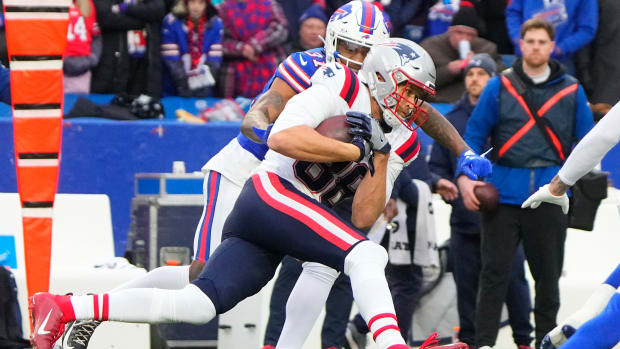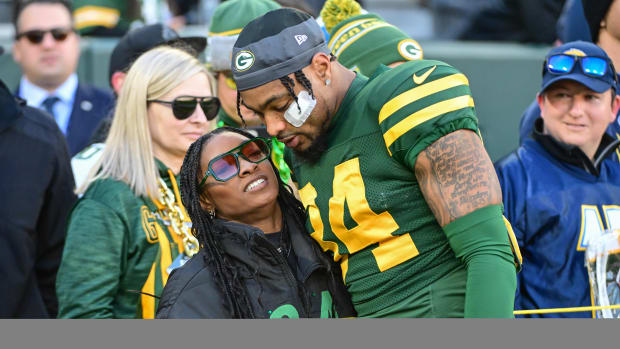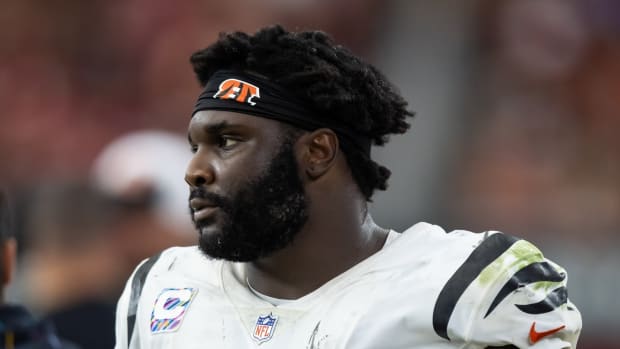The Tyreek Hill Trade, and the New Normal in NFL Roster Building
We could argue from a philosophical standpoint whether it’s a good idea to trade five picks—including a first-round pick—for a 28-year-old wide receiver who played his best football for an offensive mastermind and alongside one of the most talented quarterbacks of our generation. We could also wonder whether or not it’s a good idea to give that player the largest contract for a wide receiver in terms of average annual value in NFL history.
The Dolphins did both of those on Wednesday in a blockbuster deal with the Chiefs, adding Tyreek Hill into the fold with Jaylen Waddle in an attempt to revive the remaining years of Tua Tagovailoa’s rookie contract and jumpstart the career of new head coach Mike McDaniel.
The Dolphins did this a few days after the Raiders traded first- and second-round picks for Davante Adams, who is a year older than Hill. They gave Adams what was then the largest average annual value for a wide receiver contract, at $28 million per season. Even outside of the chaotic quarterback market this offseason, we’ve witnessed what seems like a wanton disregard from every personnel executive in the NFL toward standard operating procedure.
These deviations from the norm present us with something we cannot argue: The standard operating procedure we have used to gauge the immediate successes and failures of trades has died. It’s time to develop a new rubric for evaluating these moves, because a swath of new, much younger, general managers have taken hold of the reins and will continue to reshape the prism through which we view the modern NFL. Hill’s acquisition, Adams’s acquisition and both of their new contracts are absolute proof of this.
We’ve heard a lot about the Madden Generation of NFL players. Coaches love to casually blame the video game for every young person’s desire to play quarterback and scramble around in the backfield, sidearm slinging and diving into the end zone, scoring 45 points a game on their own. Certainly it’s reshaped the league and provided us with some wonderful and unique moments of quarterbacking greatness.
But what about the general managers of that same generation? Unlike your local newscast from 1999, we’re not blaming video games for something here, but we are pointing out that, over time, front offices have become increasingly desensitized to massive trades and the consequences of corresponding contracts that would seem gargantuan and impenetrable on the surface (but are mostly not). Maybe that’s from hours spent pasted to a PlayStation, button mashing one’s way through the warnings that say Trading For Peyton Manning Will Put Your Team $421 million Over The Salary Cap, Are You Sure You Want To Proceed? Maybe it’s from watching MLB the NBA, and their own revolutions. Regardless, we have arrived at a point where we can safely say the compensation and the ensuing contract don’t really matter—or, more accurately, we don’t know how they matter quite yet because we exist in a new normal.
We have also been alerted to the worst kept secret in the NFL: The salary cap is a joke that has been abused, manipulated and worked around for decades. Owners who want to win will spend money. Owners who don’t care are going to hide while their front office mouthpiece talks about patience and pragmatism.
What’s been beautiful about back-to-back Super Bowl wins from imperfect high rollers in Jason Licht and Les Snead is that it has shifted our focus on team building. Who cares if the Rams and the Buccaneers finish in second place three years from now? They can just trade a bunch of assets for great players and try the whole thing over again. Their success rate is going to be infinitely better than the old guard general managers who we see collecting dust, talking to us like politicians who have been promising that tax reduction for a while now. These things take time, we’re continuously told, while in other places they take no time at all.
And so, we can argue the Hill trade from every angle. Will his short-yardage ability bolster Tagovailoa’s confidence and give him an EPA boost? Will the Dolphins offense be a legitimate threat vertically? Who knows. An immediate instinct here was to rip the deal, just like we might have a few nights ago when the Adams trade went down. The instinct to do so was from years of talking to general managers and executives who did things the way they had always been done.
Quarterback money for a wide receiver? LOL.
Only it’s not so funny when all these teams start populating the playoff field and the ones left saving their pennies and stockpiling assets for some long-away crack at the Super Bowl are irrelevant. And, let’s be honest, those owners will likely soon be trying to hire away someone from the front office of a team who understands the new normal, a GM who might have played a little Madden in their life.
More NFL Coverage:
• The Davante Adams Trade Isn’t Rodgers’s Fault—But It’s His Problem
• Don’t Let the Watson Sweepstakes Losers Off the Hook
• The Browns Will Never Live Down the Watson Trade






































